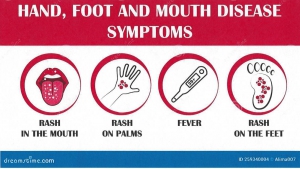Subscribe to Stay Informed
HEALTH ADVISORY #230 HAND, FOOT, AND MOUTH DISEASE
Posted 09/26/25
DATE: September 25, 2025
The West Virginia Bureau for Public Health (BPH), has identified a significant increase in reported outbreaks of hand, foot, and mouth disease (HFMD) statewide. In 2025, a total of 38 HFMD outbreaks have been reported, including 17 outbreaks since September 1, 2025.
HFMD is a common viral illness that primarily affects infants and children, with typical seasonal increases during the summer and fall months. While individual cases are not reportable in West Virginia, emergency department, urgent care and outbreak data indicate higher HFMD activity this year compared to prior years. Older adolescents and adults may also be affected.
Clinical Features
Symptoms: Sudden onset of fever, painful oral sores, and vesicular rash on the hands and feet.
Illness course: Rash develops within 1–2 days of fever onset; vesicles are typically non-pruritic.
Infectious period: Begins two days before rash onset, continues during acute illness, and may persist for weeks after symptoms resolve.
Causative agents: Most commonly Coxsackievirus A16 and Enterovirus 71.
Transmission
Spread occurs primarily through contact with respiratory secretions or stool of infected persons. Prolonged asymptomatic viral shedding is common.
Exclusion Guidance
Children and staff do not need to be excluded from school or childcare if they are:
Fever-free for at least 24 hours without fever-reducing medication
Well enough to participate in routine activities
Not experiencing uncontrolled drooling from mouth sores
Exclusion does not prevent further spread because asymptomatic individuals may shed virus for weeks.
Requiring a physician’s note is not needed to return to daycare, school, or work.
Testing
HFMD is a clinical diagnosis; laboratory testing is unnecessary in most cases.
Testing may be considered if the diagnosis is uncertain or in severe/unusual presentations (e.g., meningitis, sepsis).
Routine testing is not recommended.
Prevention and Control
Frequent handwashing (especially after diapering, bathroom use, and before food handling).
Respiratory hygiene and cough etiquette.
Regular cleaning and disinfecting frequently touched surfaces and toys.
Recommendations
1.HFMD activity is increasing statewide. Similar trends are being reported nationally. No increase in illness severity has been observed.
2.Clinicians should consider HFMD in the differential diagnosis for rash illnesses, particularly in children. Because measles continues to circulate nationally and internationally, clinicians should also remain vigilant for febrile rash illnesses that could represent measles.
3.Children with HFMD rarely require exclusion from childcare or school. Refer to outbreak guidance for exclusion criteria.
4.For further information, contact OEPS at (304) 558-5358, ext. 1, or visit the CDC HFMD resource page: CDC: About HFMD.

